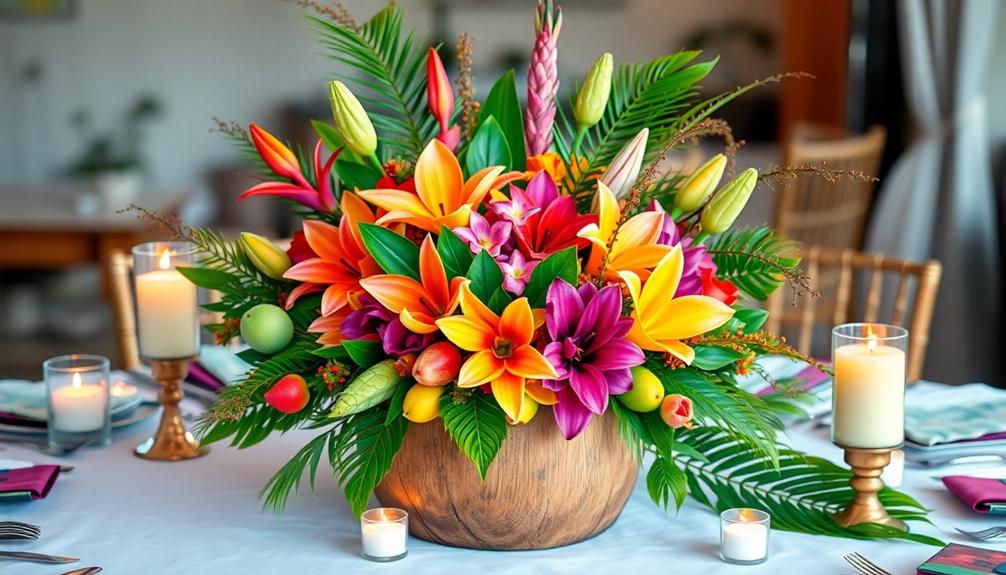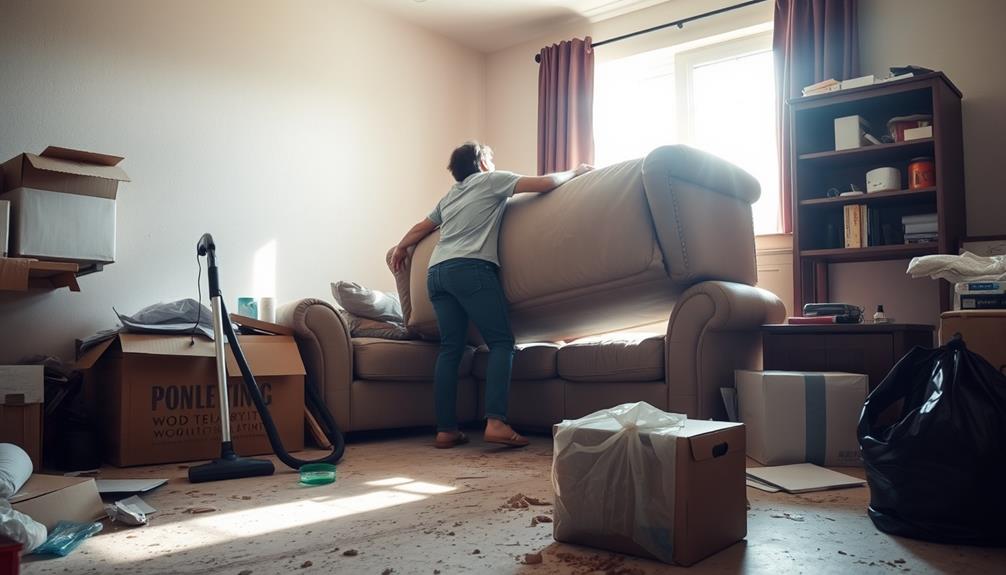Transform your event with vibrant tropical decorations to create an unforgettable experience for your guests. Incorporate bold colors, palm trees, and flamingos to set a lively atmosphere. Add eye-catching centerpieces like pineapple vases or tiki-themed accents for extra flair. Enhance your tablescape with a lush palm leaf table runner and seashell accents. Don’t forget to illuminate the space with tiki torches and string lights for a cozy ambiance. With playful decorations and colorful themes, you’ll uplift spirits and inspire social interactions. Explore more tips to elevate your tropical gathering here!
Key Takeaways
- Use vibrant colors and playful designs to create a festive atmosphere that transports guests to a tropical paradise.
- Incorporate unique centerpiece ideas like pineapple vases and tiki-themed decorations for impactful table displays.
- Enhance the ambiance with tiki torches, string lights, and tropical lanterns to create a warm and inviting glow.
- Engage guests with interactive DIY decoration stations and encourage floral attire for an immersive tropical experience.
- Utilize tropical elements like palm leaves and seashells as accents to elevate the overall theme and encourage social interaction.
Overview of Tropical Decor

When it comes to party planning, tropical decor can instantly transform your space into a vibrant, festive paradise.
You'll find that themes featuring palm trees, flamingos, and pineapples create an inviting atmosphere for birthdays, luaus, or beach-themed events. Incorporating bold colors and playful designs not only enhances the aesthetic but also elevates the guest experience.
Think about using decorations like Hawaiian luau sets or honeycomb centerpieces to add depth and excitement to your gathering. These elements serve as memorable backdrops for photos and lively interactions, ensuring your event stands out.
Centerpiece Ideas for Impact

To make a striking impression at your tropical-themed event, choosing the right centerpieces is key.
Consider vibrant floral arrangements featuring exotic orchids in shades of pink, purple, and yellow to captivate your guests. For a playful touch, honeycomb centerpieces add a 3D effect and color that draws the eye.
Tiki-themed centerpieces can evoke a sense of Hawaiian culture, making your tables feel festive. You might also opt for palm tree centerpieces, bringing the essence of the tropics right to your table.
If you're feeling creative, why not use a pineapple as a vase? This unique twist will surely stand out.
With these ideas, you'll create a memorable atmosphere that enhances your event's tropical vibe.
Essential Decoration Items

A vibrant array of essential decoration items can transform your tropical party into an unforgettable experience. Start by selecting bright and playful elements that capture the essence of the tropics. Consider using decorations like Hawaiian Luau kits, centerpiece sticks, and honeycomb table centerpieces. These items not only attract attention but are also easy to set up and take down.
| Decoration Item | Description |
|---|---|
| Hawaiian Luau Kit | 9-piece set with various tropical themes |
| Centerpiece Sticks | 18-piece set including turtles and leaves |
| Honeycomb Centerpieces | 10-piece set with colorful designs |
| Tiki-themed Decor | Fun, cultural elements for a festive feel |
| Floral Arrangements | Customizable tropical flower displays |
Utilizing these key items will elevate your party atmosphere greatly!
Unique Table Decor Tips

Building on the vibrant atmosphere created by your essential decoration items, unique table decor can take your tropical party to the next level.
Start with a lush palm leaf table runner to add a pop of green. For centerpieces, consider pineapple vase floral arrangements that capture the essence of the tropics.
Use colorful tiki masks as place cards to inject some whimsy into your settings. Seashell and starfish accents can enhance the beach vibe, while a tiki hut mini bar display serves as both decor and a drink station.
Don't forget to incorporate vibrant colors and playful designs, ensuring each table feels festive and engaging, making your guests feel transported to a tropical paradise. Consider using lush greenery, bold floral arrangements, and carefully selected linens that enhance the overall ambiance. Incorporating elegant breakfast table ideas, such as chic tableware or fresh fruit displays, can elevate the setting even further. To top it off, don’t shy away from creative centerpieces that evoke a sense of whimsy while maintaining a refined aesthetic. Adding elements like woven placemats or decorative chargers can also help elevate your breakfast table design, giving it a more polished and sophisticated look. Additionally, consider using personalized name cards or small themed trinkets at each place setting to create a memorable and thoughtful experience for your guests. Combining these details with your festive decor will ensure an atmosphere that is both exciting and serene.
Creating Ambiance With Lighting

Lighting plays an essential role in creating the right ambiance for your tropical party. It can transform your space from ordinary to extraordinary.
Here are some effective lighting options to contemplate:
- Tiki Torch Candle Holders: They provide a warm, inviting flame that sets a relaxed outdoor atmosphere.
- Tropic-Inspired Lanterns: Use these to illuminate your setting with a cozy, warm glow, enhancing the tropical vibe.
- String Lights: Drape them around trees or tables to create a whimsical, festive feel.
- Flame Ambiance Settings: Incorporate flickering flames for a mesmerizing atmosphere that draws guests in.
With these lighting elements, you'll create a vibrant and welcoming environment that keeps your guests enjoying the tropical spirit all night long.
Techniques for a Festive Atmosphere

To create a festive atmosphere at your tropical party, start by incorporating vibrant colors and playful decorations that instantly transport guests to a lively Hawaiian setting.
Use hula skirt table skirting to add a fun, tropical touch to your tables, and consider colorful grassy accents to enhance your centerpieces.
Don't forget to play lively Hawaiian music and serve tropical cocktails that keep the energy high.
Encourage guests to wear floral attire to immerse everyone in the theme.
For added charm, use tiki torches for warm lighting and create a welcoming vibe.
Finally, engage your guests with interactive elements like DIY decoration stations to make the experience unforgettable.
These techniques will guarantee your tropical party is both festive and memorable!
Advantages of Tropical Decor

Tropical decor brings numerous advantages that can elevate your event experience. By incorporating these elements, you'll create a lively atmosphere that resonates with your guests. Here are some key benefits:
- Joyful Ambiance: The vibrant colors and patterns instantly uplift spirits.
- Enhanced Interaction: A tropical theme encourages socializing, making it easier for guests to mingle.
- Thematic Consistency: Using tropical decor guarantees your event feels cohesive, allowing for seamless shifts throughout the gathering.
- Creative Photo Opportunities: The picturesque backdrops created by tropical elements invite guests to capture memories.
With these advantages, you can transform your party into an unforgettable tropical paradise, assuring everyone has a fantastic time!
DIY Decoration Inspirations

When planning your tropical party, getting crafty with DIY decorations can add a personal touch that elevates the overall vibe.
Start by creating custom centerpieces using vibrant local tropical flowers. You can also repurpose recycled materials to craft unique table decor, like colorful tiki masks or seashell arrangements.
Incorporate personal items, such as photos or cherished souvenirs, to make your setup more meaningful. Engage your guests by inviting them to join in the decoration process, turning it into a fun activity.
Ultimately, utilize natural elements like sand or palm leaves for authenticity.
With these DIY decoration inspirations, you'll create a festive atmosphere that your guests will remember long after the party ends.
Frequently Asked Questions
What Are the Best Tropical Decor Colors for My Event Theme?
For your event theme, consider vibrant colors like turquoise, coral, sunny yellow, and lush green. These shades evoke a tropical vibe, creating a lively atmosphere that'll excite your guests and elevate the overall decor.
How Can I Incorporate Tropical Decor in a Winter Party?
You can incorporate tropical decor in a winter party by using vibrant colors like teal and coral, adding palm leaves and exotic flowers, and including festive elements like tiki torches to create a warm, inviting atmosphere.
Where Can I Find Affordable Tropical Decoration Supplies?
You can find affordable tropical decoration supplies at local party stores, online retailers, or discount shops. Don't forget to check out thrift stores or DIY options for unique, budget-friendly items that add flair!
How Do I Clean and Store Tropical Decorations After the Event?
To clean and store your tropical decorations, wipe them down with a damp cloth, ensuring no residue remains. Then, carefully pack them in labeled boxes to prevent damage and make future setups easier.
Can Tropical Decor Be Used for Formal Events?
You can effortlessly elevate formal events with tropical decor. Imagine palm fronds dancing elegantly, vibrant colors swirling around. It'll mesmerize your guests, turning any gathering into an unforgettable celebration of style and sophistication.
Conclusion
As you plunge into the vibrant world of tropical decor, let your imagination soar like a parrot in paradise. With a splash of creativity and a touch of aloha spirit, you'll transport your guests to an island escape they'll cherish. Whether it's the whimsical flamingos or the swaying palm leaves, each detail you choose will weave a tapestry of joy and celebration. So go ahead, embrace the tropical vibe and turn your gathering into an unforgettable luau!









